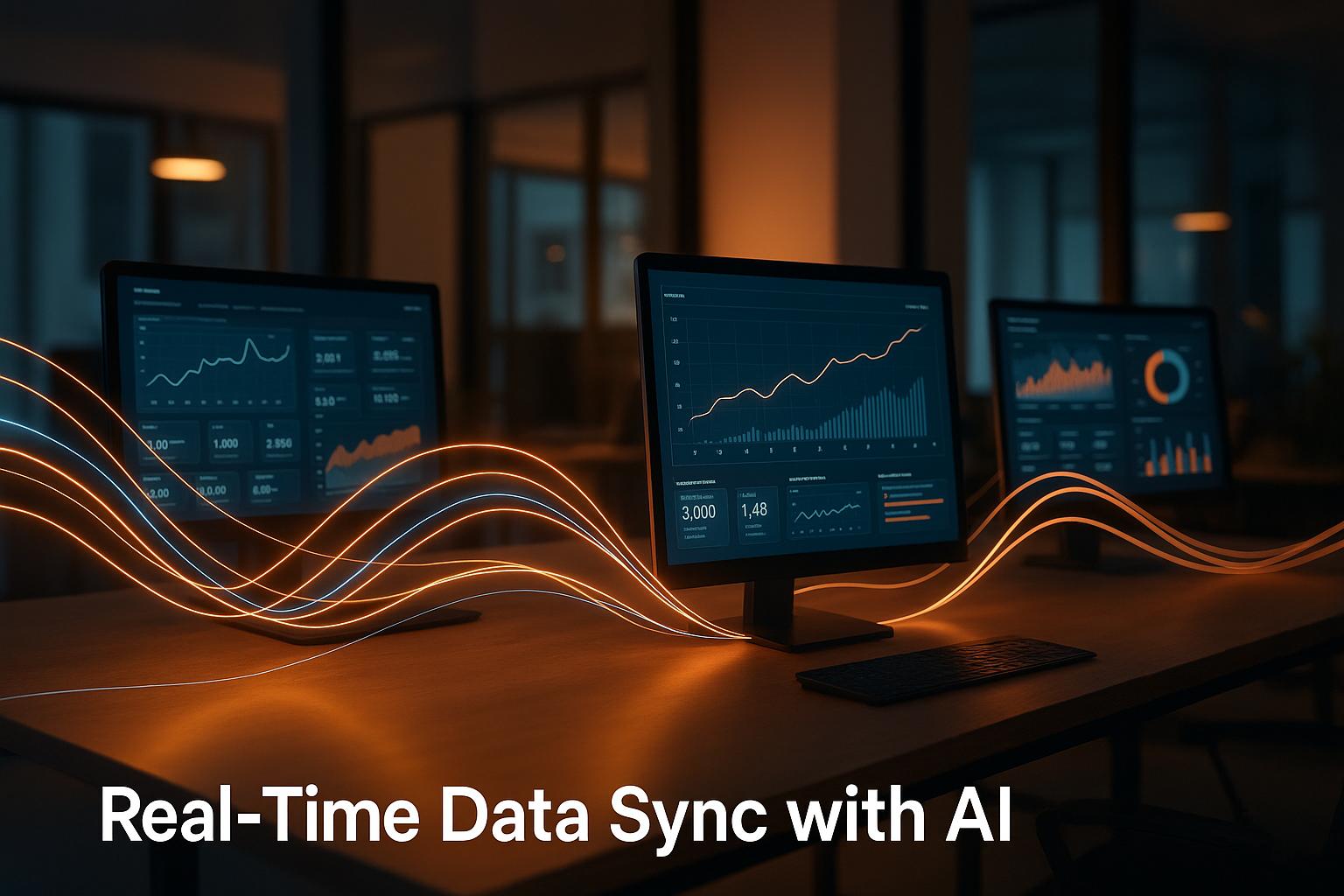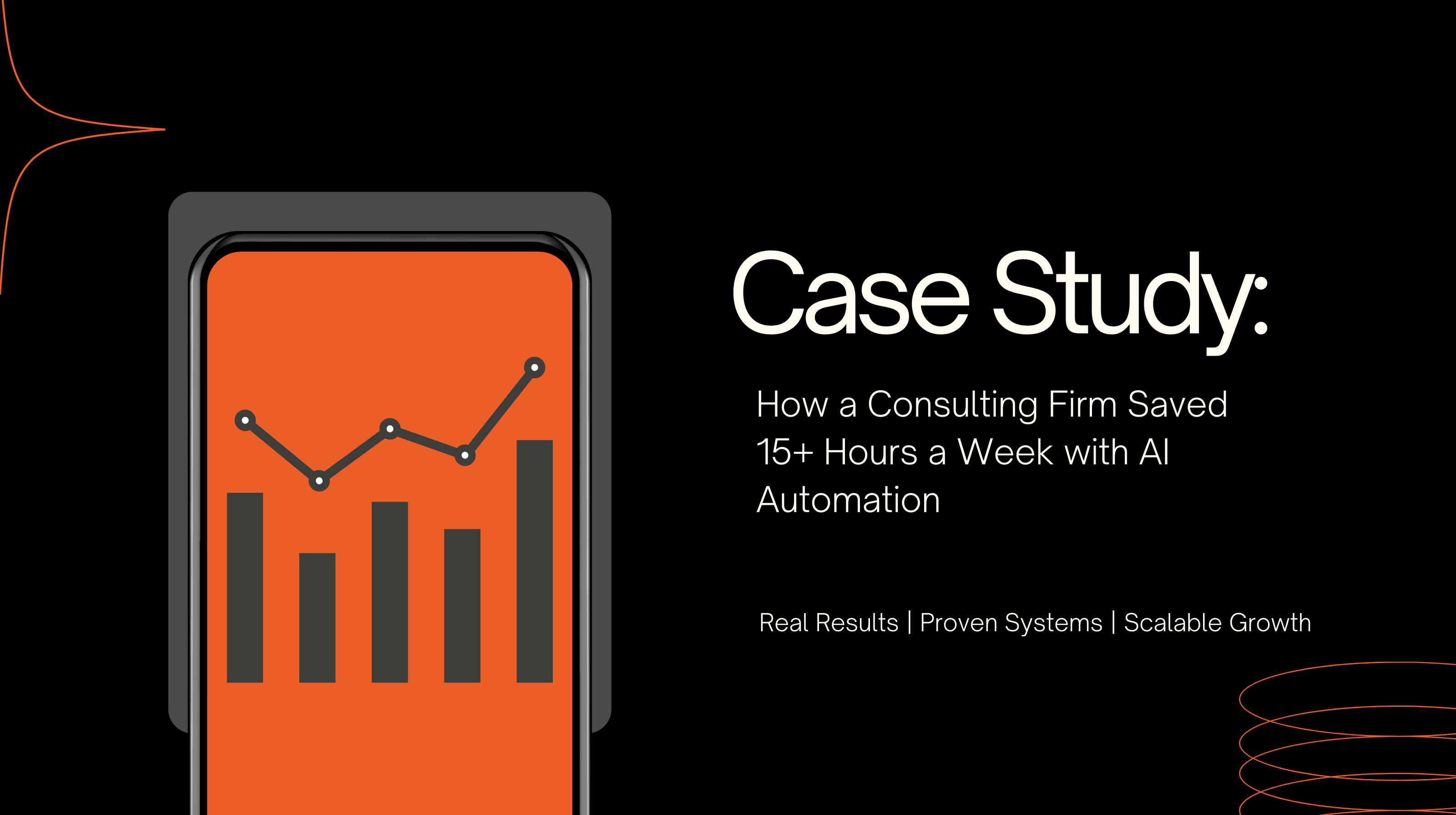Real-time data sync powered by AI is transforming how businesses operate. It ensures instant updates across systems, eliminating delays, errors, and outdated information. Here's why it matters:
Businesses like UPS, American Airlines, and Macy’s are already leveraging these tools for better performance. To succeed, focus on clear workflows, data accuracy, and regular system audits. AI-driven synchronization isn't just an upgrade - it’s a necessity for staying competitive in today’s fast-paced market.
How to handle real-time data sync at scale? | Devico Breakfast Bar #104
Key Benefits of Real-Time Data Sync
Real-time data synchronization reshapes how businesses operate by ensuring immediate and accurate data updates across all systems. This goes beyond basic data management - it transforms decision-making, enhances customer experiences, and streamlines operations.
Smarter Decision-Making with Real-Time Data
Access to real-time data allows business leaders to make informed decisions quickly, adapting strategies as needed. With seamless data flow, organizations can identify issues early and respond swiftly to market changes.
In fact, 80% of businesses reported revenue growth directly linked to real-time data technology in 2022.
A great example is Ciena, which uses Striim for real-time data synchronization. This gave them instant visibility into data across multiple platforms, enabling real-time network performance monitoring and early detection of anomalies. As a result, they could address issues quickly, ensuring uninterrupted service and higher customer satisfaction.
Real-time data also improves coordination in complex supply chains by cutting delays and bottlenecks. This allows suppliers, manufacturers, and logistics providers to collaborate more effectively and adjust to market fluctuations.
American Airlines showcases another use case. Its real-time data hub processes operational data instantly, ensuring smoother travel experiences for passengers.
These advancements in decision-making don’t just benefit the business - they directly lead to better customer engagement.
Elevating the Customer Experience
Real-time synchronization powered by AI ensures consistent and accurate customer interactions across all channels. By keeping customer profiles and service information up to date, businesses can deliver the personalized experiences that today’s consumers demand.
For instance, 98% of companies reported improved customer sentiment thanks to real-time sync, while 78% of service representatives noted an increase in customer expectations for personalized experiences . AI plays a key role here, enabling hyper-personalization by analyzing customer behaviors and preferences.
AI-powered tools like chatbots and virtual assistants leverage real-time data to provide round-the-clock support. Notably, 84% of customer service professionals believe AI is essential for meeting consumer expectations, and three-quarters say it has significantly reduced response times.
"With AI, you can offer hyper-personalized, predictive, and automated experiences at scale." – Amelia Woolard, Copywriter, Bloomreach
Real-world examples highlight these benefits. In 2025, Integral Recruiting Services used RingCentral's AI Receptionist to handle 93% of incoming calls, saving 12 hours monthly and cutting costs by $900. The AI Assistant also saved the company president 1.5 hours daily by automating note-taking.
Similarly, All Things CX, a global consultancy, implemented RingCX in 2025 to analyze customer interactions using AI-generated transcripts and sentiment analysis. This reduced handle times by 25% and centralized customer communication across digital channels, ensuring faster and more effective support.
AI also enhances the customer experience with predictive analytics, offering personalized recommendations and deals. Nearly half of customers (47%) expressed interest in receiving tailored offers from AI, and 71% of respondents in a Gartner survey reported better customer insights with AI adoption .
But the advantages of real-time sync don’t stop at customer interactions - it also delivers measurable cost savings and operational improvements.
Streamlined Operations and Cost Savings
Automating data synchronization eliminates manual errors, reduces inefficiencies, and saves money. In fact, real-time data usage led to an estimated $321 billion in savings by cutting non-people costs, with 62% of surveyed companies reporting smoother process rollouts.
Consistency across platforms is critical for avoiding costly mistakes caused by outdated or conflicting data. Every system accessing the same up-to-date information helps businesses stay on track, with 100% of surveyed companies reporting improved ability to detect irregularities .
Take Macy’s, for example. By using real-time data, they optimized inventory and order management, reducing task durations and freeing up resources for strategic projects. Kramp also transitioned from batch-load data warehousing to a cloud-based system with Striim, improving data quality and operational efficiency for machine learning applications.
Real-time synchronization helps prevent inventory issues, which can be costly. In 2022, nearly 60% of online shoppers in the U.S. said out-of-stock products influenced their buying behavior. Keeping accurate, up-to-date inventory data ensures businesses can avoid lost sales and customer dissatisfaction.
Improved collaboration is another benefit. When employees across departments work with the same real-time data, it eliminates confusion and delays caused by inconsistent information. This fosters a more efficient and cohesive organization.
Core Components and Technologies for Real-Time Data Sync
Creating effective real-time data synchronization hinges on three key technological pillars. These components work together to enable smooth data flow across business systems, fostering better operations, smarter decision-making, and stronger customer engagement. Let’s break them down.
API Integrations for Cross-Platform Communication
APIs are the backbone of real-time data synchronization, acting as digital bridges that enable instant communication between software platforms. By connecting CRMs, ERPs, eCommerce systems, and other tools, APIs eliminate data silos and create seamless pathways for information exchange.
To achieve real-time synchronization, event-driven architectures come into play, utilizing tools like webhooks, push notifications, and polling mechanisms. WebSocket technology also plays a critical role by enabling persistent, two-way communication between clients and servers. Depending on specific needs, businesses can employ streaming, Pub/Sub, push, or event-driven APIs.
Security, of course, is a top priority. Encryption, OAuth authentication, and role-based access control (RBAC) protocols ensure sensitive data stays protected during transfers. However, API-related security issues remain a challenge - 99% of organizations reported such problems in the past year, highlighting the importance of proper implementation. To enhance API efficiency, businesses should standardize data transformation protocols, use pre-processing validation rules, and adopt AI-driven anomaly detection to identify errors early. Load balancing and caching can also help handle large data volumes effectively.
By combining these connectivity protocols with AI technologies, businesses can further automate and refine their real-time data synchronization processes.
AI Algorithms for Real-Time Automation
AI takes real-time data synchronization to the next level by making it smarter and more predictive. These algorithms monitor data changes continuously, push updates across platforms automatically, and resolve inconsistencies before they disrupt operations.
Machine learning plays a vital role here, analyzing historical data patterns to predict synchronization needs and prevent potential conflicts. This proactive approach not only minimizes downtime but also ensures data integrity across connected systems.
AI also automates tasks like schema mapping and data validation, dynamically adapting synchronization strategies to match workload demands and data priorities. This flexibility ensures high performance, even under shifting conditions.
The growing importance of AI in business is reflected in its projected market value of $1.339 trillion by 2030. Additionally, AI is expected to boost the U.S. GDP by 21% within the same timeframe, showcasing its transformative economic potential.
Cloud-Based Storage and Security
The third pillar, cloud-based storage, ensures data resilience and security while complementing API and AI technologies. Cloud infrastructure offers scalable backup solutions, disaster recovery options, and compliance with U.S. data privacy standards, making it a cornerstone for safeguarding data integrity in distributed systems.
Modern cloud platforms are designed to handle the massive data volumes generated by real-time synchronization. They maintain consistent performance across multiple geographic locations, a scalability feature that becomes critical as businesses expand.
Interestingly, while 76% of business leaders view real-time data access as vital, only 33% report having mature capabilities in this area. This gap highlights the importance of robust cloud infrastructure in meeting real-time data demands.
Cloud platforms also tackle the issue of data being trapped in silos. Many companies fail to utilize much of the data they collect because it isn’t easily accessible. By offering standardized methods for accessing data across platforms, cloud APIs unlock the full potential of collected information.
To optimize cloud-based synchronization, businesses should establish clear data governance policies, monitor API usage closely, and implement compliance-driven management strategies. Techniques like API rate limiting and strong encryption protocols can further protect data both in transit and at rest.
When combined, API integrations, AI-driven automation, and cloud infrastructure create a powerful foundation for real-time data synchronization. This trio empowers businesses to stay agile, secure, and efficient while meeting evolving demands.
sbb-itb-d7ea0c6
Best Practices for Implementing Real-Time Data Sync
Implementing AI-powered real-time data synchronization effectively requires a careful balance of efficiency, security, and scalability. Below, we’ll dive into actionable practices that help translate these principles into successful processes.
Mapping Workflows and Finding Integration Points
To start, it’s essential to understand your current workflows and identify where real-time data synchronization can make the biggest impact. Workflow mapping is a great tool for this - it visually lays out tasks, decisions, and interactions, making it easier to spot inefficiencies and areas for improvement.
The key is to begin with clear objectives and measurable success metrics. This ensures your synchronization efforts align with business goals instead of becoming just a technical exercise. Involving stakeholders from various departments early on is also crucial. Their input provides a well-rounded view of data needs and context.
Mapping workflows effectively means outlining tasks, roles, decision points, and data flows. Starting with a pilot project can help validate workflows and uncover potential issues before scaling up. For instance, utility companies often use GIS mapping to monitor infrastructure and plan repairs. Field workers can capture images of damaged poles, tag their locations, and send alerts to engineers. This allows engineers to overlay geographic data with load reports, prioritize repairs, and prevent outages - all while improving reliability.
A detailed data mapping document is another must-have. It should cover everything from source-to-target mapping rules to data validation and transformation rules, as well as metadata and business rules. This level of detail ensures synchronization runs smoothly and supports better decision-making and customer satisfaction. Once workflows are mapped, the next step is focusing on data accuracy and security.
Prioritizing Data Accuracy and Security
Accurate and secure data is the backbone of effective real-time synchronization. Centralized data validation processes can ensure that incoming data is complete, properly formatted, and compatible with your systems before integration begins. APIs play a key role here by standardizing data fields and formats, reducing inconsistencies. Validation and filtering processes can also block sensitive or non-compliant data from entering workflows.
Security measures should be baked into your implementation plan from the start. As Mario Frith, Technical Director and Co-Founder at Ikonik Digital, points out:
"Security cannot be an afterthought. Use encryption protocols during data transfers. Implement authentication and regular audits. Secure APIs protect sensitive business data. This builds trust among users and stakeholders."
Encryption protocols are vital for safeguarding data, both during transfer and while at rest. Role-based access controls and authentication mechanisms help ensure only authorized individuals can access sensitive data. Embedding audit trails and logging features into synchronization processes provides transparency and helps meet compliance requirements.
Regular Audits and Optimization
Real-time synchronization systems need regular attention to keep them running smoothly and aligned with evolving business needs. Audits help assess how well the system is performing, while optimization focuses on refining processes based on feedback and new insights.
Setting clear objectives and KPIs is the first step in effective auditing. Regularly reviewing these metrics ensures they stay in sync with changing business goals. Audits should prioritize data integrity and security. Internal reviews can uncover areas for improvement, making the system more robust over time.
A great example of audit-driven optimization comes from Baldwin Risk Partners (BRP), an insurance distribution and risk management firm. In February 2025, BRP used Zilla Comply to streamline data mapping and collection from custom applications. Before Zilla Comply, their process relied on exporting data into separate Excel files - a manual and error-prone approach. Zilla Comply simplified workflows, improved accuracy, and reduced risks. It also provided auditors with clear evidence of access review accuracy through screen captures and detailed reports. Zilla’s audit logs became a reliable source of truth, boosting confidence in the process.
Regular feedback from stakeholders further sharpens synchronization efforts. Staying informed about industry trends and regulatory updates ensures your auditing process remains relevant. By iterating and refining based on feedback, you can maintain system effectiveness over time. Incorporating new tools and technologies into the audit process can also help keep your synchronization systems efficient and up to date.
How Devcore Powers Real-Time Data Sync

Devcore takes real-time data synchronization to the next level with tailored AI and automation systems that eliminate bottlenecks. Rather than sticking to generic solutions, they focus on delivering measurable results that directly boost business performance. Their track record speaks volumes: over 22,000 hours saved for clients and more than $10 million in additional revenue generated through AI-driven automation.
Their philosophy revolves around using technology to gain an edge. As they put it:
"You don't scale by adding people; you scale by adding leverage. Software scales infinitely, runs 24/7, and never calls in sick".
This principle guides their approach to real-time data sync, where automation takes the reins, ensuring uninterrupted data flow without human intervention. Their expertise spans three main areas: custom AI solutions, API integration, and scalable system design.
Custom AI Solutions for Workflow Optimization
Devcore leverages AI to simplify data synchronization by automating complex workflows and minimizing manual input. Their custom tools ensure seamless data movement - whether it’s updating CRMs or summarizing calls - without delays or errors.
One standout example is their work with an investment advisory firm bogged down by manual data entry and follow-ups. Devcore introduced an AI-powered call transcription, auto-summary, and CRM integration system that automatically captured client interactions and synchronized them across platforms. The results? An 85% reduction in administrative time, quicker follow-ups, and $30,000 saved annually on virtual assistant costs.
These AI tools don’t just move data; they analyze it, uncover opportunities, and make smart decisions about routing and prioritization. Businesses gain synchronized data and actionable insights, enabling real-time decision-making.
For a SaaS company, Devcore developed an AI lead scoring and deal-matching system integrated into their CRM. This solution assessed incoming leads, scored them based on conversion potential, and routed them to the right sales teams. The impact was clear: a 40% boost in high-quality lead conversions and 70+ hours saved monthly from manual reviews, resulting in steadier pipeline growth.
API Integration and Custom Systems
Real-time data sync demands a solid technical foundation, and Devcore excels at creating custom API integrations that seamlessly link different systems. Their services include building dashboards, optimizing workflows, and designing backend systems to manage continuous data streams.
Outdated systems often hinder communication between platforms, but Devcore solves this with API integrations that act as bridges. These integrations handle data validation, transformation, and routing automatically, avoiding format conflicts and timing issues.
Their custom systems are built to grow alongside businesses. Instead of quick fixes, they design scalable architectures capable of handling increasing data volumes and complexity. Security is a top priority, with features like encryption and tokenization safeguarding sensitive data during real-time synchronization.
Devcore’s technical team also tackles common hurdles like mismatched data formats, system compatibility issues, and varying processing speeds. By developing custom middleware and integration layers, they ensure smooth real-time sync, regardless of the underlying tech stack.
Scalable Solutions with the Leverage Blueprint™
To maximize efficiency in real-time synchronization, Devcore employs their proprietary Leverage Blueprint™. This structured framework identifies inefficiencies and implements scalable solutions tailored to specific business needs. It’s a step-by-step approach to overcoming operational bottlenecks.
The process starts with a deep dive into current workflows and data flows. Devcore maps existing systems, pinpoints integration opportunities, and determines where real-time sync can have the biggest impact. They emphasize prioritizing data quality, ensuring that data is reviewed, corrected, and standardized before synchronization.
What truly sets the Leverage Blueprint™ apart is its focus on delivering measurable outcomes. Every solution is designed to provide tangible business value, whether it’s faster decision-making, improved customer experiences, or reduced costs. As Devcore puts it:
"For our best clients, we're not a line item, we're a profit center".
The Blueprint also ensures scalability from the outset. By designing systems that generate more value than they cost, Devcore creates solutions that essentially pay for themselves through increased efficiency and revenue.
The methodology doesn’t stop at implementation. Regular strategy sessions and workflow audits keep systems optimized as business needs evolve. This turns real-time synchronization from a technical hurdle into a strategic asset that fuels growth.
Conclusion: Improving Efficiency with AI-Powered Sync
AI-driven real-time data synchronization isn't just a technical enhancement - it’s a game-changer for businesses aiming to stay ahead. Companies that embrace real-time data are 23 times more likely to attract customers, 6 times more likely to retain them, and 19 times more likely to boost profitability. For top-performing businesses, this translates into 62% higher revenue growth and 97% higher profit margins.
By combining API integrations, AI algorithms, and cloud-based storage, businesses can ensure data flows effortlessly across platforms. This tackles the age-old problem of outdated information derailing decision-making. As IBM aptly puts it:
"AI is not just about intelligence; it's about timing. The best insights lose value if they arrive too late."
The impact of these technologies is already visible. UPS has slashed fuel consumption and maintenance costs using its ORION route optimization system. Netflix delivers tailored content recommendations to millions in real time. And PayPal, leveraging AI-driven fraud detection, processed 6.5 billion transactions in Q1 2024, preventing billions of dollars in potential losses.
To implement these solutions effectively, businesses need the right strategies and partners. Best practices like mapping workflows, ensuring data accuracy, and performing regular audits are essential. Devcore’s Leverage Blueprint™ exemplifies how tailored AI solutions can lead to measurable gains in efficiency and cost reduction.
As Aerospike CEO Subbu Iyer wisely notes:
"Increasingly, we are no longer forced to choose between being really thoughtful and being really fast."
This perfectly sums up the value of AI-powered synchronization: enabling businesses to make quick, precise decisions without sacrificing accuracy. For U.S. companies aiming to scale and thrive in today’s fast-paced market, real-time data synchronization is no longer a luxury - it’s a necessity.
FAQs
How does real-time data synchronization help businesses make better decisions and improve customer experiences?
Real-time data synchronization gives businesses a powerful edge by ensuring they always have access to the most precise and current information. This capability helps teams act faster and make smarter decisions, whether they’re fine-tuning operations or adapting to shifts in the market.
For customers, real-time data translates to personalized and timely experiences - like resolving issues instantly or receiving recommendations that feel tailor-made. The result? Higher satisfaction, stronger loyalty, and an overall enhanced experience with your brand.
What technologies are used for real-time data synchronization, and how do they work together?
Real-time data synchronization depends on a combination of core technologies working together. These include event-driven architecture, message queues, data replication tools, and cloud-based synchronization platforms. Each plays a distinct role in keeping data consistent and flowing smoothly across systems.
Event-driven architecture identifies and captures changes as they happen, ensuring nothing is missed. Message queues handle the efficient transfer of updates between systems, while data replication tools keep platforms aligned by duplicating data where needed. Meanwhile, cloud-based synchronization platforms provide the flexibility and scalability required for modern operations. Together, these tools enable businesses to maintain fast, reliable, and accurate data synchronization, which is crucial for informed decision-making and smooth operations.
What are the best practices for successfully implementing AI-driven real-time data synchronization?
To implement AI-driven real-time data synchronization effectively, businesses should consider these essential practices:
These steps enable businesses to harness AI for a dependable, real-time data synchronization system, supporting better decision-making and smoother operations.
Related posts
- Manual Workflows Slowing Growth? AI Solutions
- Best AI Integration Platforms for Mid-Size Firms
- Custom AI Models for Predictive Analytics
- Using AI to Prevent Customer Churn
{"@context":"https://schema.org","@type":"FAQPage","mainEntity":[{"@type":"Question","name":"How does real-time data synchronization help businesses make better decisions and improve customer experiences?","acceptedAnswer":{"@type":"Answer","text":"<p>Real-time data synchronization gives businesses a powerful edge by ensuring they always have access to the <strong>most precise and current information</strong>. This capability helps teams act faster and make smarter decisions, whether they’re fine-tuning operations or adapting to shifts in the market.</p> <p>For customers, real-time data translates to <strong>personalized and timely experiences</strong> - like resolving issues instantly or receiving recommendations that feel tailor-made. The result? Higher satisfaction, stronger loyalty, and an overall enhanced experience with your brand.</p>"}},{"@type":"Question","name":"What technologies are used for real-time data synchronization, and how do they work together?","acceptedAnswer":{"@type":"Answer","text":"<p>Real-time data synchronization depends on a combination of core technologies working together. These include <strong>event-driven architecture</strong>, <strong>message queues</strong>, <strong>data replication tools</strong>, and <strong>cloud-based synchronization platforms</strong>. Each plays a distinct role in keeping data consistent and flowing smoothly across systems.</p> <p>Event-driven architecture identifies and captures changes as they happen, ensuring nothing is missed. Message queues handle the efficient transfer of updates between systems, while data replication tools keep platforms aligned by duplicating data where needed. Meanwhile, cloud-based synchronization platforms provide the flexibility and scalability required for modern operations. Together, these tools enable businesses to maintain fast, reliable, and accurate data synchronization, which is crucial for informed decision-making and smooth operations.</p>"}},{"@type":"Question","name":"What are the best practices for successfully implementing AI-driven real-time data synchronization?","acceptedAnswer":{"@type":"Answer","text":"<p>To implement AI-driven real-time data synchronization effectively, businesses should consider these essential practices:</p> <ul> <li><strong>Define a clear plan</strong>: Start by outlining your synchronization goals, identifying data sources, and setting desired outcomes. A well-thought-out strategy lays the groundwork for success.</li> <li><strong>Focus on data accuracy</strong>: Build systems to address data inconsistencies and prevent duplication or errors. Reliable data is the backbone of any synchronization effort.</li> <li><strong>Streamline data transfer</strong>: Employ efficient algorithms and processes to reduce latency and manage bandwidth effectively.</li> <li><strong>Protect sensitive information</strong>: Use encryption and secure access protocols to safeguard data during synchronization.</li> <li><strong>Conduct comprehensive testing</strong>: Simulate various scenarios to uncover potential issues and refine the system before full deployment.</li> <li><strong>Maintain ongoing monitoring</strong>: Regularly track system performance, pinpoint bottlenecks, and make necessary adjustments to ensure optimal functionality.</li> </ul> <p>These steps enable businesses to harness AI for a dependable, real-time data synchronization system, supporting better decision-making and smoother operations.</p>"}}]}




